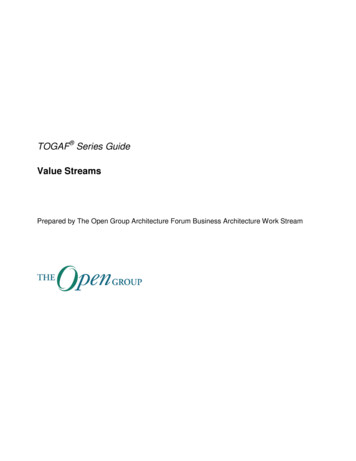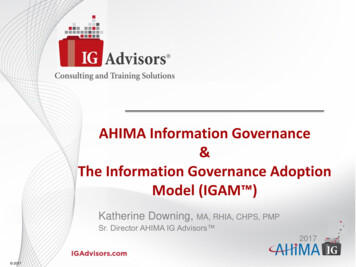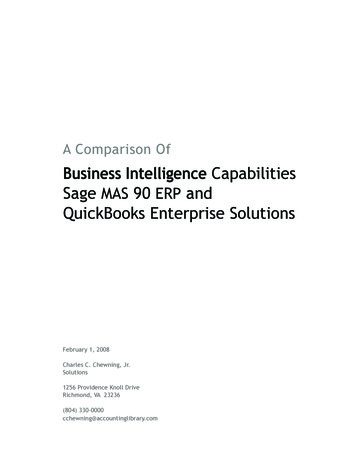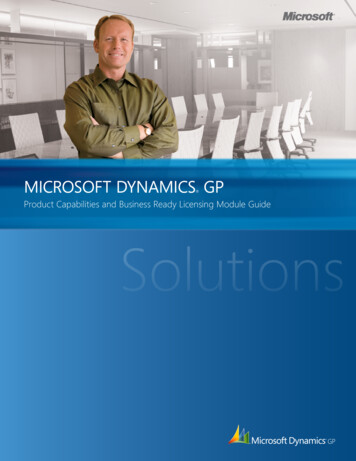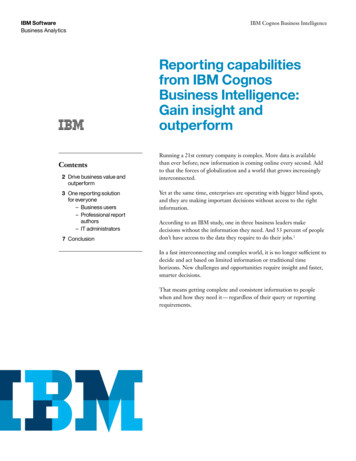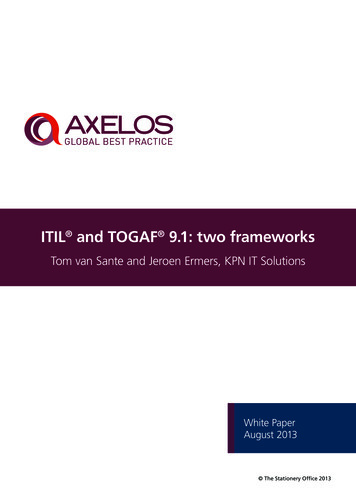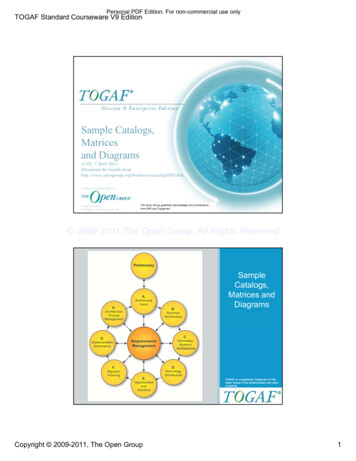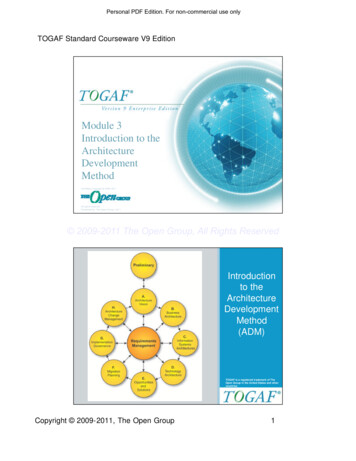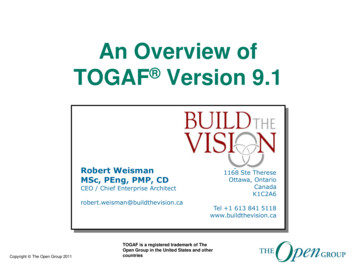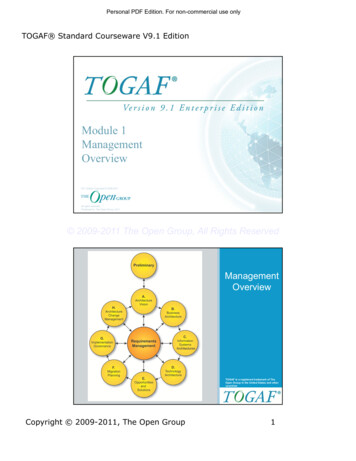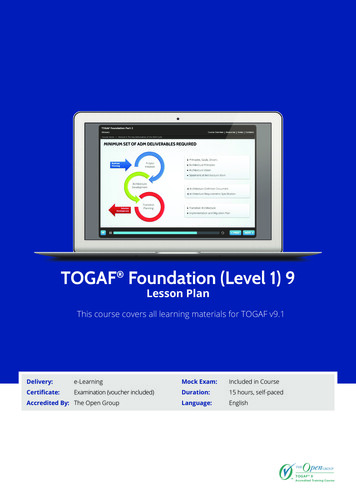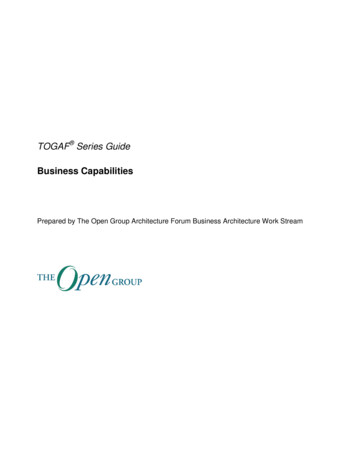
Transcription
TOGAF Series GuideBusiness CapabilitiesPrepared by The Open Group Architecture Forum Business Architecture Work Stream
Copyright 2018, The Open Group. All rights reserved.No part of this publication may be reproduced, stored in a retrieval system, or transmitted, in any form or by any means,electronic, mechanical, photocopying, recording, or otherwise, without the prior permission of the copyright owner.This Guide has not been verified for avoidance of possible third-party proprietary rights. In implementing this Guide,usual procedures to ensure the respect of possible third-party intellectual property rights should be followed.TOGAF Series GuideBusiness CapabilitiesISBN:1-947754-15-7Document Number:G189Published by The Open Group, June 2018.Comments relating to the material contained in this document may be submitted to:The Open Group, Apex Plaza, Forbury Road, Reading, Berkshire, RG1 1AX, United Kingdomor by electronic mail to:ogspecs@opengroup.orgiiTOGAF Series Guide (2018)
Contents1Introduction . 12What is a Business Capability? . 22.1 Defining a Business Capability. 22.1.1Name . 22.1.2Description . 32.2 Components of a Business Capability . 32.2.1Roles . 32.2.2Processes . 32.2.3Information . 42.2.4Resources . 42.3 Business Capability Example: Recruitment Management . 43Business Capability Modeling . 63.1 Approach. 63.1.1Organizational Structure. 73.1.2Business Model . 83.1.3Strategic Plans, Business Plans, and Financial Plans . 83.2 Structuring the Business Capability Model . 93.2.1Level One Capability Stratification . 93.2.2Leveling . 94Mapping Business Capabilities to Other Business Perspectives . 114.1 Heat Mapping . 114.2 Cross-Mapping. 124.2.1Capability/Organization Mapping . 134.2.2Capability/Value Stream Mapping . 135Conclusion . 15Business Capabilitiesiii
PrefaceThe Open GroupThe Open Group is a global consortium that enables the achievement of business objectivesthrough technology standards. Our diverse membership of more than 600 organizations includescustomers, systems and solutions suppliers, tools vendors, integrators, academics, andconsultants across multiple industries.The Open Group aims to: Capture, understand, and address current and emerging requirements, establish policies,and share best practices Facilitate interoperability, develop consensus, and evolve and integrate specifications andopen source technologies Operate the industry’s premier certification serviceFurther information on The Open Group is available at www.opengroup.org.The Open Group publishes a wide range of technical documentation, most of which is focusedon development of Open Group Standards and Guides, but which also includes white papers,technical studies, certification and testing documentation, and business titles. Full details and acatalog are available at www.opengroup.org/library. The TOGAF Standard, a Standard of The Open GroupThe TOGAF standard is a proven enterprise methodology and framework used by the world’sleading organizations to improve business efficiency.This DocumentThis document is a TOGAF Series Guide to Business Capabilities. It has been developed andapproved by The Open Group.The document supersedes The Open Group Guide: Business Capabilities (G161).More information is available, along with a number of tools, guides, and other resources, atwww.opengroup.org/architecture. About the TOGAF Series GuidesThe TOGAF Series Guides contain guidance on how to use the TOGAF framework. They formpart of the TOGAF Body of Knowledge.The TOGAF Series Guides are expected to be the most rapidly developing part of the TOGAFdocument set. While the TOGAF framework is expected to be long-lived and stable, guidance onthe use of the TOGAF framework can be industry, architectural style, purpose, and problemivTOGAF Series Guide (2018)
specific. For example, the stakeholders, concerns, views, and supporting models required tosupport the transformation of an extended enterprise may be significantly different than thoseused to support the transition of an in-house IT environment to the cloud; both will use theArchitecture Development Method (ADM), start with an Architecture Vision, and develop aTarget Architecture on the way to an Implementation and Migration Plan. The TOGAFframework remains the essential scaffolding across industry, domain, and style.Business Capabilitiesv
TrademarksArchiMate , DirecNet , Making Standards Work , OpenPegasus , Platform 3.0 , The OpenGroup , TOGAF , UNIX , UNIXWARE , and the Open Brand X logo are registeredtrademarks and Boundaryless Information Flow , Build with Integrity Buy with Confidence ,Dependability Through Assuredness , Digital Practitioner Body of Knowledge , DPBoK ,EMMM , FACE , the FACE logo, IT4IT , the IT4IT logo, O-DEF , O-PAS , OpenFAIR , Open O logo, Open Platform 3.0 , Open Process Automation , Open TrustedTechnology Provider , SOSA , and The Open Group Certification logo (Open O andcheck ) are trademarks of The Open Group.All other brands, company, and product names are used for identification purposes only and maybe trademarks that are the sole property of their respective owners.viTOGAF Series Guide (2018)
About the AuthorsThis Guide was developed by the Business Architecture Work Stream of the ArchitectureForum, a forum of The Open Group.Alec Blair – Program Lead, Enterprise Architecture, Alberta Health ServicesAlec has been working as an Enterprise Architect and Enterprise Architecture manager/coach forthe last 15 of his 28 years in the IT industry. Alec currently leads the Alberta Health ServicesEnterprise Architecture community of expertise. This virtual team spans more than 40practitioners working on all dimensions of Enterprise Architecture.Stephen Marshall – Strategy Consultant, IBMStephen Marshall is a Master Certified Architect with The Open Group, a Certified BusinessArchitect (CBA), and a Senior Management Consultant with the IBM Institute for BusinessValue (IBV). He currently leads the IBV Global C-suite Study program in Asia-Pacific, coauthoring several pieces of thought leadership over the past three decades.Business Capabilitiesvii
AcknowledgementsThe Open Group gratefully acknowledges the authors and also past and present members of TheOpen Group Architecture Forum for their contribution in the development of this Guide:viii Sonia Gonzalez – The Open Group Kirk Hansen – Metaplexity Associates Harry Hendrickx – HPE Rich Hillard – Project Editor, ISO/IEC/IEEE 42010 Gerard Peters – Capgemini Pieter Steyn – Enterprise ArchitectsTOGAF Series Guide (2018)
Referenced DocumentsThe following documents are referenced in this TOGAF Series Guide.(Please note that the links below are good at the time of writing but cannot be guaranteed for thefuture.) Ulrich Homann: A Business-Oriented Foundation for Service Orientation, White Paper,February 2006 Karen Martin, Mike Osterling: Value Stream Mapping, McGraw Hill, 2014, ISBN: 978-007-182891-8 The TOGAF Standard, Version 9.2, a standard of The Open Group (C182), published byThe Open Group, April 2018; refer to: www.opengroup.org/library/c182Business Capabilitiesix
xTOGAF Series Guide (2018)
1IntroductionMany organizations struggle with managing the complexity of their business. They want toanswer questions about their progress toward realizing their strategic aims. Are their strategicinvestments targeted appropriately? Are there areas for rationalization of redundancy orduplication? Does the business have what is necessary or too much to succeed?As the discipline and practice of Business Architecture has continued to grow and mature, theconcept of the “business capability” has emerged to become a fundamental component in thedevelopment of a Business Architecture.Business capabilities provide an abstraction of the business reality in a way that helps to simplifyconversations between interested stakeholders. Defining a business capability’s supportingcomponents (roles, processes, information, and tools) provides a business context for thosesupporting components. Creating a business capability model for the enterprise promotes moreof a common understanding of the business.Defining business capabilities and a capability model is a means to an end. Business leaders andplanners need business capabilities as a foundation to make better business decisions. Theinsight to make better decisions happens by mapping the business capabilities to differentbusiness perspectives and viewpoints. This mapping allows for a more coherent view of thebusiness to emerge.Business and Enterprise Architects are the primary audiences for this Guide. Business leadersand planners may also find it useful to understand how to leverage business capabilities as partof other business strategy and planning initiatives.This Guide looks to answer some important questions about what a business capability is andhow it is being used to enhance business analysis and planning: What exactly do we mean by the term “business capability”? Why are business capabilities such an integral part of Business and EnterpriseArchitecture, and the architecture development process? How do we describe business capabilities? How (and why) should we construct a business capability model? How do business capabilities map to other business perspectives?Business Capabilities1
2What is a Business Capability?Within The Open Group, a capability is defined as “an ability to do something”. A businesscapability represents the ability for a business to do something. A more formal definition is asfollows:A business capability is a particular ability or capacity that a business may possess or exchangeto achieve a specific purpose or outcome. (See A Business-Oriented Foundation for ServiceOrientation by Ulrich Homann.)Critically, a business capability delineates what a business does without attempting to explainhow, why, or where the business uses the capability. For more on the use of business capabilitiesin the context of Enterprise Architecture, see recent updates to the Business Architecture phasein the TOGAF Standard, Version 9.2 (§7.5.3: Applying Business Capabilities).As part of the practice of Business Architecture, we separate the concern of what we do fromwho does it within the organization and from how the business achieves value from that activity.A business capability can be something that exists today or something that is required to enable anew direction or strategy. When integrated into a business capability model, business capabilitiesrepresent all of the abilities that an enterprise has at its disposal to run its business.2.1Defining a Business CapabilityDefining a business capability involves identifying and describing what needs to be done by thebusiness in support of its overall mission. A business capability description does not imply howwell something needs to be done, simply that it needs to exist. The following guidelines explainhow to define an individual business capability.2.1.1NameNaming the business capability is the first step in the capability definition process. It establishesa clear need for the existence of the business capability and helps to ensure that it is clearlydistinguishable from other business capabilities. The correct naming convention involvesexpressing the business capability as a noun (“this is what we do”) as opposed to a verb (“this ishow we do it” – usually associated with processes). In practice, business capabilities are mostoften written as compound nouns; e.g., “Project Management” or “Strategic Planning”.The most important consideration is to adopt names that will resonate with business leaders andstakeholders. Commonly understood names enable better understanding and improvecommunication across different stakeholder groups. However, resist the urge to repeat simplythe organizational department names. Unlike business capabilities (which are inherently stable),organizational structures are not enduring and frequently change in most organizations.2TOGAF Series Guide (2018)
2.1.2DescriptionA brief description helps to clarify the scope and purpose of the business capability and todifferentiate it from other business capabilities. A useful syntax is to phrase the description ofeach business capability as “the ability [or capacity] to ”. For example, a business capabilitynamed “Strategic Planning” might be described as “the ability to develop and maintain thestrategic plan and overall direction of the organization”.As with the business capability name, write all descriptions using language that is relevant andappropriate to the business stakeholders. Two important considerations are to:2.21.Be concise: Provide just enough detail over one or two sentences to enable greaterunderstanding than can be gained from the business capability name alone.2.Be precise: Do not simply repeat the name of the business capability in the description,such as “the ability to manage projects” when describing “Project Management”.Components of a Business CapabilityA combination of roles, processes, information, and tools enable a business capability. Theprocess of reviewing each of the business capability components helps refine the businesscapability name and description and supports the subsequent analysis of business capabilitygaps, duplications, and redundancies. This decomposition can be used as a test to check that thecapability definition is, in fact, a business capability (rather than a process, organizationalfunction, or service).Business capabilities are coarse-grained concepts that enable business planning from differentviewpoints. Business capabilities are built to focus on what the business does rather than how thebusinesses use business capabilities to deliver business value. That said, in order for a capabilityto be defined, we need to understand how the capability is realized in the form of roles,processes, information, and tools. The key distinction is that the business capability componentswill change regularly, but the business capability endures over longer planning horizons. Thehow of a capability must be self-contained within the capability.2.2.1RolesRoles represent the individual actors, stakeholders, business units, or partners involved indelivering the business capability. A single organizational group or team may be whollyresponsible for delivering the capability, or multiple business entities may share the delivery of aparticular business capability. Do not describe roles in a way to be organizationally-specific.Similarly, role-specific business capabilities should be reviewed as they may be just acomponent of another business capability, or need more elaboration to become a more fullydescribed business capability.2.2.2ProcessesIndividual business capabilities are usually enabled or delivered through a range of businessprocesses. Identifying and analyzing the efficiency of the core processes helps to optimize thebusiness capability’s effectiveness. By identifying just the processes within a businesscapability, it provides a focus to mature the capability in concert with the other capabilitycomponents.Business Capabilities3
It may seem contradictory to have the how of processes as a way to define a capability. InSection 4.2.2, which talks about value streams, we describe a technique to look at how tosequence capabilities in a way to develop the context of how using the business capabilitycontributes to delivering stakeholder value.2.2.3InformationInformation (in this context) represents the business information and knowledge required orconsumed by the business capability (as distinct from IT-related data entities). There may alsobe information that the capability exchanges with other capabilities to support the execution ofvalue streams. Examples include information about customers and prospects, products andservices, business policies and rules, sales reports, and performance metrics.2.2.4ResourcesBusiness capabilities rely on a range of tools, resources, or assets for successful execution. Thesetools may include:2.3 IT systems and applications Physical, tangible assets like buildings, machinery, and vehicles Intangible assets like money and intellectual propertyBusiness Capability Example: Recruitment ManagementThis business capability example is called “Recruitment Management” and follows the structuredescribed above.Table 1: Business Capability Example – Recruitment ManagementNameRecruitment ManagementDescriptionThe ability to solicit, qualify, and provide support for hiring newemployees into the organization.ComponentsRolesUser: RecruiterStakeholders:Processes Manager Candidate EmployeeEvaluate New Hire RequisitionsRecruit/Source CandidatesScreen and Select CandidatesHire Candidate4TOGAF Series Guide (2018)
NameRecruitment ManagementInformationCandidate/Applicant DetailsPosition DescriptionsRecruitment Agency DataIndustry Standard Role DefinitionsResourcesRecruitment Management ApplicationHR ApplicationSocial Media ApplicationBusiness Capabilities5
3Business Capability ModelingA business capability model represents the complete, stable set of business capabilities (alongwith all of their defining characteristics) that covers the business, enterprise, or organizationalunit in question. The end product of the modeling process is typically a business capability map,which provides the visual depiction (or blueprint) of all the business capabilities at anappropriate level of decomposition, logically grouped into different categories or perspectives tosupport more effective analysis and planning.Once defined, the business capability model provides a self-contained view of the business thatis independent of the current organizational structure, business processes, IT systems andapplications, and the product or service portfolio. However, mapping the business capabilitiesback to organizational units, value streams, IT architecture, and the strategic and operationalplans will provide greater insight into the alignment and optimization of each of those domains.3.1ApproachThe first goal of business capability modeling is to capture and document all of the businesscapabilities that represent the full scope of what the business does today (irrespective of howwell it does it) or what it desires to be able to do in the future. The second step is to organize thatinformation in a logical manner; this activity is discussed further in Section 3.2.Building the first business capability map for your enterprise involves significant stakeholderconversations combined with following rigorous principles for what constitutes a businesscapability. Input from many business representatives is critical, but ensuring the description isabout the business’ ability to achieve a certain outcome without specifying organizationalelements, roles, technologies, and such is equally critical. Building the map for the first time canstart with a strategy-oriented top-down approach or a bottoms-up approach driven byrepresentatives from all different areas of the business: Top-down: A top-down business capability model approach starts by identifying (from anenterprise-level perspective) the highest-level business capabilities, each of which candecompose into more detailed levelsSenior business leaders can ratify – if not help – to develop the top-level businesscapabilities in the first instance. In practice, developing a draft business capability modelfrom the top down is a more efficient use of time, but only succeeds by meaningfullyinvolving senior executives. Bottom-up: When more time is available, business capabilities can be defined fromwithin different parts of the business and built from the bottom upHowever, this approach can be more difficult to reconcile across the business withoutstrong governance and senior leadership support toward ultimately developing anenterprise-wide business capability model.6TOGAF Series Guide (2018)
Usually, a combination of top-down and bottom-up approaches allows for the refinement of thebusiness capability model. Regardless of the approach, there are three good sources ofinformation with which to create an initial draft of the business capability model:3.1.1 The organizational structure The business model Current strategic, business, and financial plansOrganizational StructureOften, organizations are structured in ways that closely align to business capabilities. Peopleexecute processes and allocate resources or tools like money, IT, or other company assets. Theorganizational structure of a business can thus be used to inform the capability model.A common mistake is to transpose the organizational chart onto the frame of the businesscapability model itself. Quite often, multiple business units are involved in creating or deliveringa single business capability. Organizational structures are also far more transient by nature thanbusiness capabilities. Avoid where possible a tight alignment between the functional names thatdenote business units, and the top-level business capabilities.For example, ABC Company has four main functional areas, each with smaller departments thatreport up to the parent business unit, as shown in Figure 1:1Figure 1: ABC Company Functional AreasAn initial investigation with the managers responsible for each of the business units in theorganization chart yields the following starter set of business capabilities: Sales:1This chart is not a complete list of possible business capabilities, much like any first pass where there is not enough time to meetwith all stakeholder groups or there is not enough information to define a particular capability.Business Capabilities7
— Account Management— Customer Management— Market Planning— Channel Management— Partner Management— Agent Management Finance:— Financial Management— Information Management Human Resources:— HR Management Operations:— Capital Management— Policy Management— Product Management— Government Relations Management— Distribution Management— Procurement Management— Operations Management— Training Management3.1.2Business ModelBusiness capabilities provide the building blocks upon which to realize an enterprise’s businessmodel (or business models, as is often found in larger corporations or conglomerates, or when anorganization is going through a transformation process). Mapping business capabilities to eachelement of the business model ensures that the enterprise’s activities and investments are moreclosely aligned and are more targeted in support of the overall vision and strategy.3.1.3Strategic Plans, Business Plans, and Financial PlansUse the published strategy and operational business plans to identify any business capabilitiesthat are considered strategic to the organization. Strategic business capabilities are those thatprovide a distinct competitive advantage and that represent a firm’s core competencies – thefoundation of companies’ competitiveness, sustainability, and future growth prospects.Prioritizing and focusing attention on the strategic and core capabilities will provide the greatestreturn on the investment of time and effort because those are the areas that produce the greatestvalue for customers and, ultimately, for the business.8TOGAF Series Guide (2018)
An assessment of the business’ financial plans should also highlight additional businesscapabilities that are essential for the business to operate, especially those that consumesignificant financial resources.3.2Structuring the Business Capability ModelThere are two concepts for turning the set of business capabilities into a logical structure thatcommunicates the right amount of detail to different stakeholder groups. Creating thesestructures will allow them to focus on those capabilities that are most important or relevant totheir sphere of influence: stratification and leveling.3.2.1Level One Capability StratificationStratification is the process of classifying, grouping, and aligning business capabilities within(usually three) categories, tiers, or layers. The purpose of stratification is to break the modeldown to be more easily understood. A collection of 20-30 capabilities without some form ofstratification is difficult to read and understand.Each stratification tier provides a different perspective or focal point for different stakeholdergroups, allowing them to organize their analysis and subsequent planning activities in morestructured ways. For example, the top tier is often aimed at the executive function’s span ofcontrol: business capabilities related to strategy and direction-setting. The middle tier typicallyrepresents the core, customer-facing elements of the business, while the bottom tier groups thosebusiness capabilities that are essential for the business to function but are more behind-thescenes playing a supporting role.Table 2 represents an example of a Level 1 business capability model for ABC Company,derived from all the inputs discussed in the previous section.Table 2: Example Level 1 Business Capability Model for ABC CompanyStrategicCoreSupporting3.2.2Business PlanningMarket PlanningPartner ManagementCapital ManagementPolicy ManagementGovernment Relations ManagementAccount ManagementProduct ManagementDistribution ManagementCustomer ManagementChannel ManagementAgent ManagementFinancial ManagementHR ManagementProcurement ManagementInformationManagementTraining ManagementOperations ManagementLevelingLeveling is the process of decomposing each top-level (Level 1) business capability into lowerlevels to communicate more detail – at a level appropriate to the audience or stakeholder groupconcerned. Some business capabilities intuitively decompose as part of the modeling process.Others only become evident when capabilities are mapped to show other perspectives.Business Capabilities9
For example, senior executives may only be interested in the Level 1 view of the businesscapability model. Architects and planners expect to see a much greater degree of granularity.The number of levels of decomposition is limited only by the degree necessary to communicatethe information required by the intended audience or to enable the business to make informeddecisions about capability gaps. Between three and six business capability levels ofdecomposition is common in practice.Figure 2 shows the Human Resource Management business capability decomposition. Here,Human Resource Management is the Level 1 business capability. There are four Level 2business capabilities, including Recruitment Management, which in turn has been decomposedinto three Level 3 business capabilities.Figure 2: Human Resource Management Business Capability Decomposition10TOGAF Series Guide (2018)
4Mapping Business Capabilities to Other BusinessPerspectivesHaving identified and organized the business capabilities into a business capability model, wecan now start to apply the information to business analysis and planning.There are two aspects to consider:4.11.Heat mapping the business capability model itself2.Mapping the relationships between the business capabilities and other business and ITarchitecture domainsHeat MappingHeat maps can show a range of different perspectives. These include maturity, effectiveness,performance, and the value or cost contribution of each capability to the business. Differentattributes determine the colors of each capability on the business capability map. Typically, astoplight metaphor highlights, at a glance, those capabilities that may need further attention. Forexample, a business capability maturity heat map shows capabilities at the desired level ofmaturity as green; one level away as yellow; and two or more levels away as red. Other colorsmay indicate other status levels; e.g., purple denotes the business capability does not exist todaybut is desired in the future. Missing capabilities signify a significant gap.The heat map shown in Table 3 represents ABC Company’s business capabilities when viewedfrom a capability maturity perspective.Business Capabilities11
Table 3: Heat Map for ABC Company’s Business CapabilitiesStrategicCoreSupportingBusiness PlanningMarket PlanningPar
The TOGAF standard is a proven enterprise methodology and framework used by the world’s leading organizations to improve business efficiency. This Document This document is a TOGAF Series Guide to Business Capabilities. It has been developed and approved by The Open Group. The document supersedes The Ope
